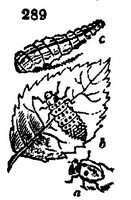1654. The Aphides, or Plant-lice (called by many the green-fly), truly belong to the Hemiptera; and, next to locusts, they are the most universal devastators of vegetables. Almost every cultivated plant is attacked by them: and their fecundity is so prodigious, that Reaumur has proved that, in five generations, one aphis may be the progenitor of 5,904,900,000 descendants; and it is supposed that in one year there may be ten generations. This astonishing fecundity exceeds that of any other known animal; but some, especially those of wheat, oats, and barley, appear to multiply in a much less degree. The species are numerous, and are appropriated to different plants. The aphides which appear very early in the spring are produced from eggs deposited upon the branches the preceding autumn, and hatched about the time that the buds begin to unfold their first tender leaves. The first brood is, however, vivaparous�in other words, producing its young alive; and this continues during summer; but towards autumn they become oviparous: were not this the case, the cold of winter would cause their total extermination. The most remarkable circumstance attending their propagation is, that the sexual intercourse of one original pair is sufficient for all the generations which proceed from the female for a whole succeeding year. Richardson thinks that all of the first spring brood are females; and if this supposition be correct, the rapid increase of their numbers during April and May may be easily accounted for. Some writers say that the larva, chrysalis, and perfect insects (all of which have logs), cannot be distinguished from each other; and others consider that those without wings are the females: there is reason, however, to think the reverse of this to be the case; as it is well known that, during summer, swarms of aphides may be seen on the wing, and are known to settle on places not before infested by them; this is usually attended with the production of a new colony, which must obviously come from the females. The injury they cause is produced by sucking or pumping out the juices of the shoots by means of a long rostrum, which usually lies inflected and concealed beneath the breast, and is enclosed in a sheath of five joints. Those feeding upon the different kinds of pulse, and on flowering plants in general, increase so rapidly, and take such entire possession of whatever they fix upon, that vegetation is checked and often destroyed. Indeed, one species attached to the potato has been asserted by Mr. Smee to be the real cause of the disease by which that vegetable has been so extensively destroyed in several of the late seasons (1845-8). This assertion has, however, been rejected by all the best vegetable physiologists. These insects are exposed to many devouring enemies, which are incessantly (though in a great measure unobservedly) employed in their destruction. Every gardener must have seen sparrows and other small birds pecking them from rose bushes; but his most friendly coadjutor in this beneficial work is the grub (fig. 289. b) of the lady-bird or lady-cow (Coccinella L.) (a). It is observed that vast numbers of these interesting little beetles are generally seen in years when the plant-louse abounds. Mr. Kirby states, that in 1807, the shore at Brighton and on the south coast was literally covered with them, to the great surprise and even alarm of the inhabitants, who were ignorant that their little visitors were emigrants from the neighbouring hop-grounds, where, in their larva state, each had slain his thousands and tens of thousands of the aphis, known to the hop-growers under the name of the Fly. The larv� of many real flies (Syrphus F.) (fig. 289. c) make astonishing havoc among the aphides. 'It was but last week,' Mr. Kirby continues, 'that I observed the top of every young shoot of the currant-trees in my garden curled up by myriads of these insects. On examining them this day, not an individual remained; but beneath each leaf are three or four full-fed larv� of aphidivorous flies surrounded with heaps of the skins of the slain; and the young shoots, whose progress had been entirely checked, are again expanding vigorously.' (Int. to Entomology, vol. i. p. 226.) The destructive insect found on apple trees, known under the name of the American blight, is a species of this family. It is a minute insect covered with long cotton-like wool, and takes its station in the chinks and hollows of the bark. It there increases so rapidly, that, if not destroyed, the tree to which it is attached will inevitably perish.

